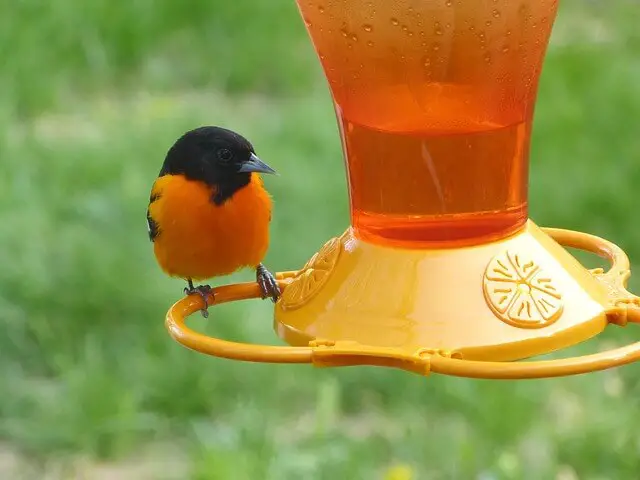
Dive into the captivating world of the Baltimore Oriole, a vibrant bird known for its stunning plumage and melodious songs. From its migratory patterns to its unique behaviors, there’s a wealth of fascinating insights awaiting discovery. Join us as we uncover the remarkable traits and fun facts that make the Baltimore Oriole a beloved symbol of beauty and grace in the avian kingdom.
Table of Contents
- 1 Key Takeaways
- 2 Baltimore Oriole Fun Facts
- 2.1 Identifying Characteristics
- 2.2 Size and Weight
- 2.3 Songs and Vocalizations
- 2.4 Range and Habitat
- 2.5 Food Sources and Diet
- 2.6 Lifespan and Nesting Habits of the Baltimore Oriole
- 2.7 Migration Patterns and Behavior
- 2.8 Conservation Status of the Baltimore Oriole
- 2.9 Attracting Baltimore Orioles to Your Garden
- 2.10 Creating an Ideal Roosting Area for Baltimore Orioles
- 2.11 Provide Water Sources
- 2.12 Install a Suet Feeder
- 2.13 Provide a Nesting Box
- 2.14 Plant Trees and Shrubs
- 3 Conclusion
- 4 Frequently Asked Questions
- 5 Author
Key Takeaways
- Baltimore Orioles are vibrant birds known for their striking orange and black plumage, adding a splash of color to any backyard.
- Their melodious songs bring a delightful musical touch to their presence, creating a harmonious atmosphere in your surroundings.
- By providing a suitable habitat with trees, shrubs, and offering nectar and fruits, you can attract these beautiful birds to your yard.
- Observing Baltimore Orioles in their natural habitat offers a rewarding experience, deepening our appreciation for their beauty and encouraging their conservation.
Baltimore Oriole Fun Facts
Identifying Characteristics
The Baltimore Oriole (Icterus galbula) is a striking bird with distinct features. The male displays a vibrant black head, back, and wings, contrasting with white wing bars.
Its most captivating attribute is its flaming orange-yellow throat, chest, and belly. The Baltimore Oriole boasts a slender, pointy beak.
In comparison, the female is slightly smaller and less bulky than the male.
Size and Weight
The Baltimore oriole is a charming, medium-sized songbird, measuring approximately 17 to 22 cm (6.7 to 8.7 in) in length. With its graceful wingspan spanning 23 to 32 cm (9.1 to 12.6 in), this vibrant species boasts an average weight of around 34 g (1.20 oz).
| Species | Length | Wingspan | Weight |
|---|---|---|---|
| Baltimore Oriole | 17-22 cm (6.7-8.7 in) | 23-32 cm (9.1-12.6 in) | 34 g (1.20 oz) |
Songs and Vocalizations
Experience the enchanting melodies of the Baltimore Orioles, renowned for their captivating songs.
Delighting the ears with their melodious tunes, their song is a symphony composed of four distinct parts: a melodious trill, two sets of cheerful chirps, and a graceful ending whistle.
These exquisite vocalizations are most commonly heard during the winter months, from November to February, adding a touch of musical delight to the serene winter landscape.
Range and Habitat
The Baltimore Orioles (Icterus galbula) are widely distributed across Eastern North America, as well as parts of Asia and Africa. During the winter months, they migrate to the northern part of Mexico for their wintering grounds.
In terms of habitat, Baltimore Orioles primarily inhabit deciduous forests characterized by tall trees, dense undergrowth, and thickets of vines.
They are also commonly seen in suburban neighborhoods, where they find suitable nesting sites and ample food sources.
These vibrant birds have a preference for small open areas, such as gardens and meadows, where they can forage for insects, nectar, and fruit.
During the night, Baltimore Orioles tend to spend most of their time high up in the trees, adding to their mystical allure.
With their striking appearance and melodious songs, these birds are cherished guests for backyard gardeners and nature enthusiasts alike.
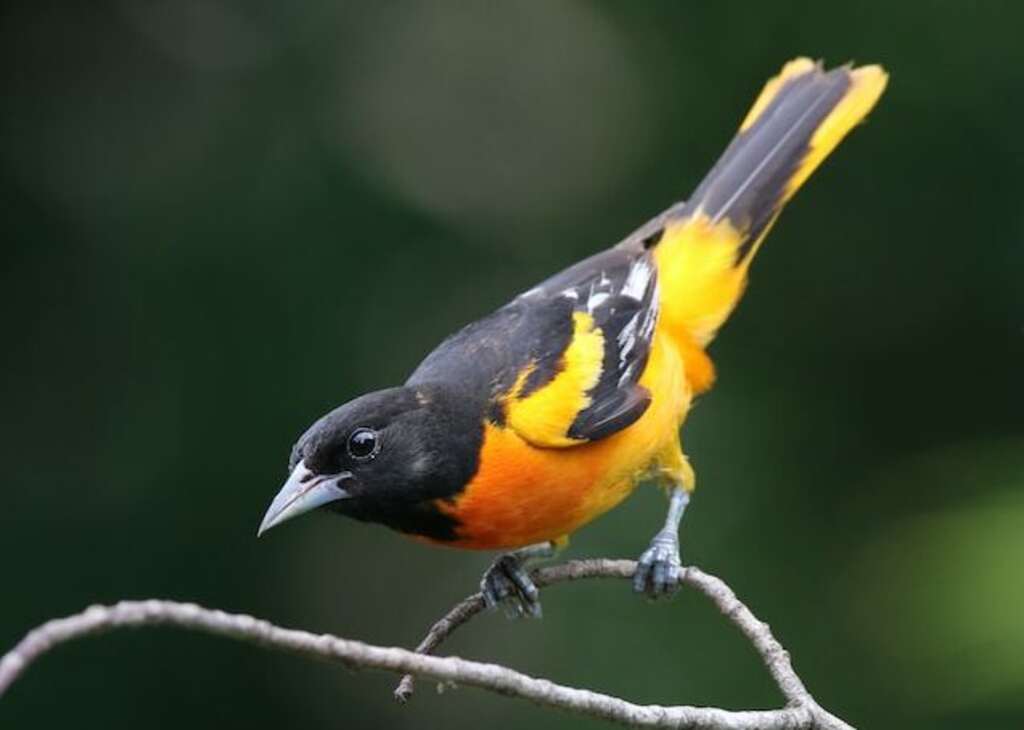
Food Sources and Diet
One of the key factors in attracting orioles to your garden is providing a diverse and abundant food supply.
These native North American species have a varied diet that includes fruit, insects, carrion, and seeds.
Baltimore Orioles are particularly fond of flies, bees, wasps, beetles, caterpillars, spiders, and other flying insects. They also feed on small invertebrates like snails and slugs.
By offering a wide range of food sources, you can create an enticing haven for them in your garden.
Lifespan and Nesting Habits of the Baltimore Oriole
The Baltimore Oriole (Icterus galbula) has a relatively short lifespan compared to other birds of similar size, typically living up to around 11 years.
These vibrant birds reach maturity and establish their permanent residence amidst the branches and trees of their chosen environment.
When it comes to nesting, Baltimore Orioles show a preference for locations near water sources and natural features such as trees and shrubs.
The nesting process begins with a male individual selecting a suitable site and gathering materials to construct the nest.
Once the nest is complete, the male initiates courtship by serenading females with melodious songs from elevated perches, aiming to attract a mate. After successful mating, the female lays eggs within the nest.
Interestingly, the male assumes all the responsibilities related to nesting. He diligently incubates the eggs for a period of 12–14 days until they hatch.
Once the young hatchlings emerge, the male ceases to provide direct care, but he remains watchful until their flight feathers fully develop, which usually takes about four weeks.
Notably, Baltimore Orioles exhibit nest site fidelity, reusing the same nest year after year.
This behavior presents fresh opportunities for attracting new mates and potential reproductions, contributing to the growth of their population across successive generations.
With only a limited number of birds needed to ensure their survival, this nesting strategy proves advantageous for sustaining their numbers.

Migration Patterns and Behavior
The migration patterns and behavior of the Baltimore Oriole (Icterus galbula) have been extensively studied, revealing fascinating insights into their annual journeys.
These vibrant birds spend their winters in Central America, predominantly in Mexico. As the seasons change, they embark on a remarkable migration back to their breeding grounds in North America.
- Migratory Route: The Baltimore Oriole follows a well-documented path, commencing their northward journey in late February. They initially traverse a southerly route through Texas before reaching Florida, where they continue their migration up the East Coast.
- Northern Breeding Grounds: Orioles can be spotted as far north as New England during their breeding season. They establish nests and engage in courtship rituals, bringing their vibrant colors and melodious songs to these regions.
- Return to Wintering Grounds: As summer transitions to fall, Baltimore Orioles make their way back south, heading towards their wintering grounds. These tropical destinations include islands like Jamaica and Cuba, where they spend the colder months.
- Solo Migration: Unlike some bird species that migrate in flocks, Baltimore Orioles predominantly undertake their journeys individually. Each bird navigates the vast distances on its own, relying on innate navigation skills honed over generations.
- Impressive Distances: It is awe-inspiring to consider the distances covered by migratory birds. Baltimore Orioles can migrate up to 3,000 miles each year, exemplifying their remarkable endurance and navigational abilities.
- Record-Breaking Migration: Some Baltimore Orioles have achieved extraordinary feats during their migration. The longest recorded journey for an individual bird was an astounding 910 miles traveled over a span of seven days.
The migration patterns and behavior of the Baltimore Oriole showcase the incredible resilience and adaptability of these avian travelers.
Their annual journeys contribute to the biodiversity and ecological dynamics of both their breeding and wintering habitats.
Understanding and appreciating their migratory feats further highlight the need for conservation efforts to protect these remarkable species.
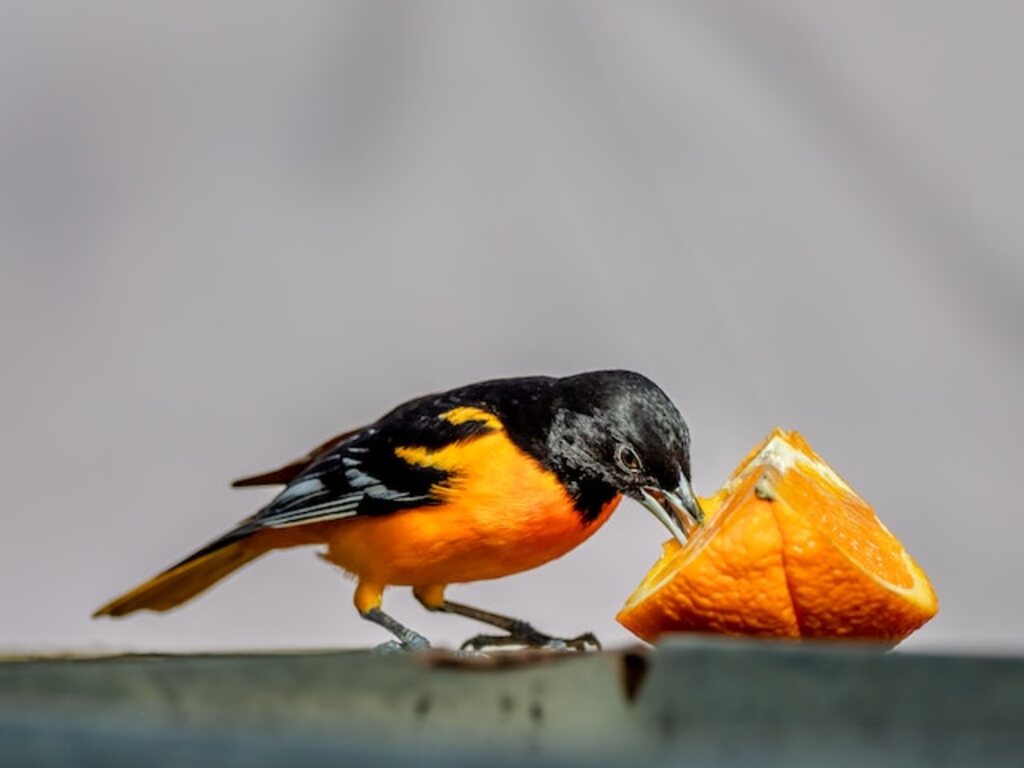
Conservation Status of the Baltimore Oriole
The Baltimore oriole (Icterus galbula) holds a significant place as an iconic symbol of the Eastern seaboard. However, this once-ubiquitous species has experienced a concerning population decline since 1990. The decline can be attributed to various factors, including habitat loss and competition with other bird species.
- Habitat Loss: The destruction and fragmentation of the oriole’s natural habitats, such as deciduous forests and riparian areas, have significantly impacted their populations. Deforestation, urbanization, and agricultural expansion have all contributed to the loss of suitable breeding and foraging grounds.
- Competition: The Baltimore oriole faces competition from other bird species, particularly in areas where habitat overlap occurs. Increased competition for resources, including nesting sites and food sources, can put additional pressure on the species.
- Climate Change: The changing climate poses new challenges for the Baltimore oriole. Shifts in temperature and precipitation patterns can disrupt their breeding and migration cycles, affecting their ability to find suitable habitats and food sources.
- Changing Agricultural Landscape: Changes in agricultural practices, such as the use of pesticides and the conversion of natural habitats into monoculture fields, have adverse effects on the oriole’s survival. These changes reduce the availability of insects and nectar, essential food sources for the species.
Conservation efforts are crucial to address the declining population of the Baltimore oriole and ensure its long-term survival. Key actions include:
- Habitat Conservation: Protecting and restoring the oriole’s preferred habitats, such as forests and riparian areas, is vital. This involves promoting responsible land management practices, preserving critical nesting sites, and creating habitat corridors to connect fragmented areas.
- Public Awareness and Education: Increasing awareness about the importance of the Baltimore oriole and its conservation needs is crucial. Educating the public, birdwatchers, and landowners about the species’ habitat requirements and promoting bird-friendly practices can contribute to its protection.
- Collaboration and Research: Collaborative efforts among researchers, conservation organizations, and government agencies are essential for monitoring populations, studying their ecology, and implementing effective conservation strategies. Research can provide valuable insights into the specific threats faced by the Baltimore oriole and guide targeted conservation actions.
By addressing these challenges and implementing conservation measures, we can work towards stabilizing and recovering the Baltimore oriole population.
Preserving the Eastern seaboard’s symbol not only benefits the species itself, but also contributes to the overall health and diversity of our ecosystems.

Attracting Baltimore Orioles to Your Garden
Baltimore Orioles are renowned for their beautiful songs and beneficial presence in gardens. To entice these vibrant birds, you need the right strategies.
One effective method is offering orange halves on a specialized oriole feeder, like the Double-Cup Jelly Oriole Feeder with Pegs.
This purpose-built feeder, available on Amazon, ensures a delightful dining experience for Orioles in your yard. Discover expert tips and tricks to create an irresistible haven for these stunning birds.
Creating an Ideal Roosting Area for Baltimore Orioles
To entice Baltimore Orioles into your yard, establishing a suitable roosting area is crucial. A pro-tip for attracting these vibrant birds is to offer a diverse selection of food within the roosting space.
Orioles are known to forage for food from above, making it an ideal location to provide a variety of seeds, pellets, and small mealworms.
By creating a well-stocked roosting area, you can significantly increase your chances of attracting and delighting these beautiful birds.
Provide Water Sources
To entice the magnificent Baltimore Orioles to grace your yard, it’s essential to offer them a reliable water source. A birdbath is an excellent choice as these birds have a deep affinity for water.
Consider investing in a quality birdbath like the one available on Amazon, designed to cater to their love of refreshing dips and splashes.
Watch as these vibrant creatures flock to your garden, bringing joy and beauty to your outdoor space.
Install a Suet Feeder
Baltimore Orioles, with their vibrant plumage and melodious songs, are a coveted sight in any garden. If you’re eager to welcome these iconic birds to your home or garden, a suet feeder can be a game-changer.
I highly recommend the Suet Buffet Bird Feeder with a durable Metal Roof, paired with irresistible orange suet.
This winning combination has consistently attracted Orioles to my garden. Don’t forget to supplement their diet with juicy oranges, a favorite treat that will keep them coming back for more!
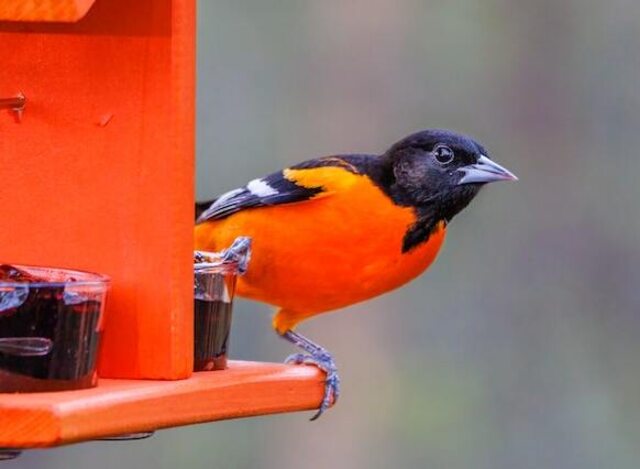
Provide a Nesting Box
Invite the captivating Baltimore Orioles to make your garden their home by providing specially designed nesting boxes. Transform your yard into a sanctuary for these vibrant birds to nest and raise their young.
Follow these simple steps to provide a safe and comfortable habitat:
- Location: Choose a spot with ample height, preferably 8–12 feet above the ground. Ensure the area is away from direct sunlight and sheltered from strong winds.
- Mounting: Securely attach the nesting box to a sturdy post or tree trunk using screws or nails. Ensure it is firmly fixed to prevent swaying or falling.
- Orientation: Position the entrance hole facing away from prevailing winds, typically east or southeast. This protects the nesting birds from harsh weather conditions.
- Height and Safety: Place predator guards, such as baffles or cones, below the box to deter climbing animals like raccoons and snakes.
- Nesting Materials: Orioles prefer natural materials like grass, moss, and plant fibers. Leave nearby vegetation untouched to allow easy access to these resources.
- Monitoring and Maintenance: Regularly check the nesting box for cleanliness, damage, or unwanted occupants. Clean out old nests after each breeding season to prepare for new occupants.
By following these steps, you can create an inviting haven for Baltimore Orioles, offering them a safe and cozy place to build their nests and raise their young. Enjoy the beauty and melodious songs of these remarkable birds right in your own backyard.
Plant Trees and Shrubs
To entice Baltimore Orioles to grace your yard with their vibrant presence, strategic selection of trees and shrubs is key.
These avian beauties seek shelter for rest and roosting, along with perches for daytime hideouts.
Embrace the allure of nature by incorporating plants like dogwood, apple, holly, lilac, oak, elderberry, cedar, crab apple, cherry, pawpaw, redbud, honeysuckle vines, forsythia bushes, blueberry shrubs, and viburnum.
With this curated landscape, watch as Baltimore Orioles dance amidst a harmonious sanctuary.
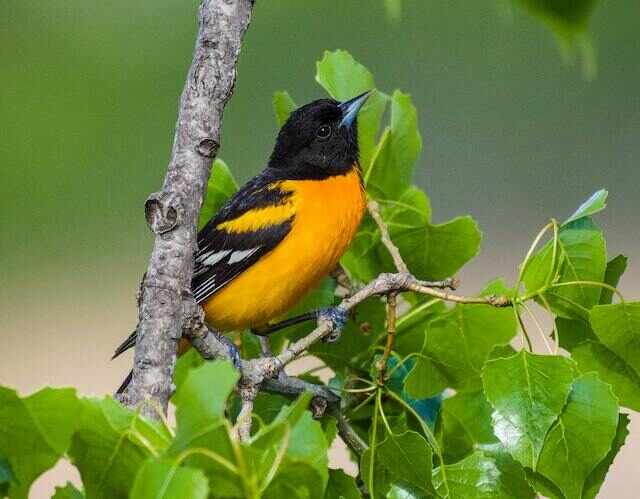
Conclusion
In conclusion, delving into the world of Baltimore Oriole bird facts has been an enchanting journey. We have discovered their vibrant plumage, melodic songs, and their fascinating migration patterns.
By understanding their habitat preferences and dietary habits, we can create welcoming spaces for these beautiful birds in our own gardens.
So, let’s embrace the wonders of nature and make our yards a haven for the delightful Baltimore Orioles to thrive and grace us with their presence. Happy birdwatching!
Frequently Asked Questions
Are Baltimore Orioles aggressive birds?
Baltimore Orioles will only become defensive if threatened or their nest is in danger. They make noise when defending themselves by hissing and making a rattling sound with their wings, which can scare off predators. When the Baltimore Oriole sees a potential threat nearby, it will fly into trees and shrubs as warning before attacking aggressively if the intruder does not leave its territory quickly enough.
Do Baltimore Orioles kill Hummingbirds?
It is not well known that birds of prey such as hawks and owls are often the culprits behind these mysterious deaths, but it has been shown that this is not always the case. The Baltimore Oriole does indeed sometimes eat small animals like hummingbirds.
Will Baltimore Orioles eat bananas?
Baltimore Orioles love to eat various types of fruit such as bananas, peaches, apples, plums, cherries, mulberries, and berries.
What kind of trees do Orioles nest in?
Orioles prefer deciduous trees with holes in them such as oak, elm, and maple trees for nesting their eggs because they provide protection from predators and help keep the nest dry during rainstorms.
Are Baltimore Orioles rare?
Baltimore Orioles are not rare at all. They are over 12 million individuals found in the Northeastern part of North America and across the entire Eastern United States, as well as Canada. The birds live year-round near water and forests, which is why they can be seen in many areas around the country.


